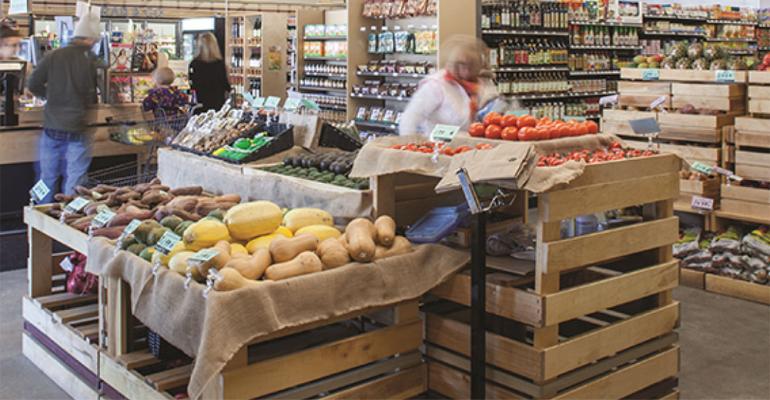Stroll down the aisles of Natural Products Expo West or Natural Products Expo East and you’ll discover innovations in packaged foods galore. Puffed snacks made from chickpeas. Nutrition bars formulated with meat and dried fruits. Corn-free tortilla chips made with cassava root and coconut flour. Shelf-stable snacks and center-store staples are continuously reinvented, rebranded and reimagined to boost nutrition, flavor and experience for shoppers. What you won’t see at many trade shows, however, is much creativity surrounding key grocery store products such as perishable grab-and-go items and fresh produce that actually capture a significant portion of natural retail sales.
There are many factors working against the survival of natural retail stores. Conventional groceries have expanded their natural sections, making special diet and preservative-free items a cinch to find. Online grocery sales are slowly rising and are at risk of cannibalizing brick-and-mortar sales. A 2016 survey by Morgan Stanley Research found that from 2015 to 2016, online grocery sales increased 8 percent for fresh food and 16 percent for packaged food (over the same time period, personal care and household product sales grew the fastest, at 24 percent). Shoring up fresh and convenience items may be key in securing natural retail’s future.
Natural Foods Merchandiser has covered extensively the evolving retail landscape that highlights the outer ring of the store—the area that many registered dietitians and nutritionists regard as where the better-for-you foods are located—and the shrinking of the inner aisles rife in processed, packaged food. In response, retailers are prioritizing categories such as produce, dairy and grab-and-go to offer a point of differentiation. That difference can be described as “fresh.” Produce, dairy and grab-and-go offer shoppers something that online sales can’t: the opportunity to examine, smell, feel and ultimately buy specific fruits, vegetables and other ready-to-consume items themselves. Mainstream media outlets are recognizing this phenomenon, too. “Shoppers who don’t buy groceries online most often cite the desire to pick their own produce as the reason,” the Wall Street Journal reported earlier this year. That desire has led many retail experts to believe that periphery categories could be the shield that halts future invasion from online sales.
These sections aren’t without their own unique set of problems, however. Produce is limited by seasonality, short shelf life and quality. Trendy dairy options such as Greek yogurt and organic milk—as well as plant-based dairy alternative products—are now found in nearly every natural, specialty, conventional and convenience store around the country. Grab-and-go faces serious competition from the $1.5 billion meal delivery market.
Around the country, natural retailers are implementing smart solutions that strengthen sales in these critical categories, placing them at a higher likelihood to thrive in the ever-changing grocery store business.
Produce power-up
Fruit and vegetable farmers typically don’t receive noteworthy investments from budding food accelerators, and apart from the several newish crop varietals that have taken hold within the past years (Hello, Honeycrisps! Hello, finger limes!), innovations in produce offerings are few and far between. It also doesn’t help that marketing budgets for fresh fruits and vegetables are miniscule compared to packaged food brand budgets. But fresh produce sections are important for natural products retailers that typically see strong margins in this area—and fruit and vegetable sales are rising in natural.
In the 52 weeks ending April 21, 2017, sales of produce in the natural channel grew an impressive 17.7 percent to $276 million, according to SPINS—almost double the amount of produce growth in conventional grocery stores during the same period. This is good news, because the Food Marketing Institute recently found that baskets including fresh produce gleaned larger sales in conventional grocery stores—they’re about $30 larger than baskets without fresh produce. Also of note is that, because produce doesn’t keep as long as processed, shelf-stable products, health-seeking shoppers will make more frequent visits to stores to purchase produce—good for your store’s brand recognition and community-building initiatives.
But discerning natural shoppers can be tough to please when it comes to produce. Minor blemishes on the surface of fruits and vegetables are enough to lose a sale, and a lifetime of having access to seasonal produce year-round has conditioned consumers to want everything—and want it now. “One of the main challenges we have for the produce department is that people want certain organic items all the time,” explains Sean Balsley, general manager for Nature’s Food Patch in Clearwater, Florida, whose produce section is 90 percent organic. “For instance, grapes often aren’t available organically year-round, so we have to weigh whether we sell non-organic grapes from Chile or just not stock them.” Not stocking them means risking the loss of an entire basket because shoppers may go to a conventional store instead. One solution? Try educating your staff about produce seasonality to arm them with honest answers when passionate shoppers ask why certain items aren’t organic for part of the year. Also post signage by your non-organic items explaining why you made stocking decisions. Being transparent in your produce sourcing is paramount to maintaining trust between your store and your customers.
The continued desire for local fruits and vegetables is also a boon to produce sections. Not only can prioritizing local produce support farmers in your area, boosting the community feel of your store, but also shoppers are OK with paying a premium for local items. One recent survey from Packaged Facts found that nearly half of respondents said they were “willing to pay up to 10 percent more for locally grown or produced foods, and almost one in three said they are willing to pay up to 25 percent more.” These figures could represent serious sales boosts in an important category.
But local produce buying can be a headache—one that John Crane, general manager of Maine’s almost three-year-old Portland Food Co-op, knows all too well. “Our sales in the produce department were increasing,” explains Crane, who says local produce is particularly important to his customers. “But we were having trouble [with the category] at the management level. We were working with a lot of individual farmers, and that communication was taking place on 20 to 30 emails, phone calls or text messages per day.” Juggling dozens of local produce purveyors was inefficient, costing time and staffing hours.
His fix? When a Maine-based startup called Forager approached Crane to test a local food-ordering tool, he enthusiastically agreed. Forager, a "digital procurement-to-payment platform," is designed to streamline the entire process of sourcing local food. Farmer partners post what they have available in the morning, and buyers order produce and other food items directly from their smartphones. Crane estimates that using Forager saves him up to 8 percent in labor costs. "Our farmers appreciate the platform, too," says Crane. "It gets us away from having to respond to so many back-and-forth emails, and farmers can receive and process orders while they are out in the field."
Grab-and-go get-down
Probably any grocer would say that customers are significantly more interested in healthy convenience items than they were five years ago. With entertainment centered on cooking and gastronomy, DIY projects and kitchen culture seems to be growing—and yet, when it comes down to quotidian actions, people aren’t cooking meals as much as they used to. This is not a new trend. According to a study published in Nutrition Journal, since 1965 Americans, regardless of income, have been eating more meals outside the home. Plus, the glorification of working late and having long hours, and the prestige of constant busyness (blame it on start-up culture), have pushed cooking regular meals to the wayside.
Recognizing the vacuum for products that serve time-pressed, health-focused consumers, brands, meal kit delivery companies and natural retailers have rapidly overhauled business models to include quick-cook, heat-and-eat or preportioned ingredients to make feeding families less of a hassle.
Grab-and-go sections of grocery stores particularly catch the attention of retailers because shoppers are willing to pay more for time saved. “Convenience is king, with increasing convenience garnering higher price premiums. Consumers pay increasingly higher price premiums for the convenience of having to do less,” analyst Camilla Stice said in a 2016 Lux Research report on new food business models.
In response, smart retailers are retooling their store floor plans to capitalize on this trend that doesn’t seem to be going away anytime soon. Simple changes to the grab-and-go section—such as creating more multi-servings (rather than single servings) of heat-and-eat meals crafted in its kitchen helped Nature’s Food Patch increase annual category sales around 30 percent. “Growth itself is from the dinner crowd,” says Balsley. “Families want something that they don’t need to put a lot of thought into but can consume almost instantly … it sure beats going to McDonald’s."
While much has been written about the popularity of delivery meal kits and their potential encroachment on grocery store sales, they aren’t necessarily the harbinger of doom some media have chocked them up to be. While Packaged Facts found that one in four Americans reported purchasing meal kits in 2016, a separate report by the firm 1010data discovered that after several weeks of purchases, meal kit purveyors such as Blue Apron, Hello Fresh and Plated saw sharp declines in repeat users: after roughly six months, only about 10 percent of customers continued meal kit delivery service.
 Plus, food retailers of all stripes are fighting back by leveraging their expert prep-kitchen chefs to make their own meal kits—and because they don’t require delivery, they’re sold in a fraction of the packaging that refrigerated, shipped meal kits contain. For example, earlier this year Publix started to offer bagged meal kits in two of its stores, positioned in a highly visible refrigerator and emblazoned with craveable images of the meals inside. Ranging in price from $9.99 to $37.99 for a family of four, shoppers can choose what level of prep-work they desire that night, from the slightly involved “SimplerPrep” Chipotle Shrimp Tacos to “SimplestPrep” heat-and-eat Caramelized Onion Meatballs. While the meal kits are still in their testing phase, media and community relations manager Brian West says Publix is very pleased with meal kit sales. “It appeals to those with varying levels of comfort and experience in the kitchen,” he says. “A general trend in grocery retail is always trying to deliver to the needs of your customers, and convenience is a piece of that."
Plus, food retailers of all stripes are fighting back by leveraging their expert prep-kitchen chefs to make their own meal kits—and because they don’t require delivery, they’re sold in a fraction of the packaging that refrigerated, shipped meal kits contain. For example, earlier this year Publix started to offer bagged meal kits in two of its stores, positioned in a highly visible refrigerator and emblazoned with craveable images of the meals inside. Ranging in price from $9.99 to $37.99 for a family of four, shoppers can choose what level of prep-work they desire that night, from the slightly involved “SimplerPrep” Chipotle Shrimp Tacos to “SimplestPrep” heat-and-eat Caramelized Onion Meatballs. While the meal kits are still in their testing phase, media and community relations manager Brian West says Publix is very pleased with meal kit sales. “It appeals to those with varying levels of comfort and experience in the kitchen,” he says. “A general trend in grocery retail is always trying to deliver to the needs of your customers, and convenience is a piece of that."
Natural retailers also capture improved sales by widening their convenience options in beverage. Exciting data show fortifying your beverage department—which Natural Foods Merchandiser’s Market Overview identified as 11.7 percent of total store sales from 2015 to 2016—can be a game-changing income slugger. SPINS data reveal that beverage sales in the grab-and-go category are particularly impressive. In the year ending April 21, 2017, sales of functional beverages (which often contain energizing herbs, spices, botanicals or add-ins like whey or plant-based protein) spiked 5.9 percent to $175.9 million. It’s also notable that, while grab-and-go milk and nondairy options in single servings represented fewer sales at $19.4 million, this category grew a remarkable 49.2 percent during the same time period. Recognizing the boost that grab-and-go beverages could offer, Nature’s Food Patch recently expanded its section that contained small juices, infused waters and fizzy kombucha by 8 feet, displacing the retailer’s beer offerings. Balsley estimates that this one improvement boosted grab-and-go beverage sales by about 20 percent from last year—numbers that will definitely slake your thirst.
Dairy good
Out of all the categories in natural retail stores, dairy might look the most foreign to a time traveler from 2007. Milk is organic, grass fed and in some cases made from plant-based foods such as nuts, seeds and beans. Yogurt is thick, creamy, Greek and often vegan. In some stores, milk may even be flanked by other refrigerated offerings such as whole-food nutrition bars. Such innovation over the past decade has made the dairy case an important section of the grocery store. Surveys from NFM’s Market Overview tell us that dairy accounted for 7 percent of total sales in natural retail in 2016. Notably, 67 percent of the dairy category is organic—the second-highest percentage of organic out of all categories except fruits and vegetables.
Offerings of novel products that cater to special diets and consumers interested in globally inspired options are key growth drivers in dairy. For example, refrigerated plant-based milk and creamers grew 12.6 percent in the year ending April 21, 2017, according to SPINS—indicative of the high-quality vegan milk products that have permeated the market in recent years. While cow’s milk garners more sales overall, it grew at a paltry 3.8 percent. But it’s the explosion of yogurt and kefir that truly reinvigorated the dairy category: over the same period, refrigerated yogurt and kefir grew 5.2 percent to an incredible $225.4 million in the natural channel.
“Yogurts that sell really well now are the ones that have something special about them. The days of original yogurt are gone,” Balsley says. “Now, most shoppers are looking for Greek yogurt, almond milk yogurt or even particular yogurt that comes from water buffalo milk.”
Skyr, too, the protein-packed, ridiculously thick Icelandic yogurt (that is technically a cheese) is gaining serious traction in dairy and, according to Nielsen, is even stealing sales from Greek yogurt consumers. For example, Icelandic Provisions, a skyr brand that employs 200-year-old skyr cultures as a fermenting agent, is the fastest growing yogurt brand in the United States. Icelandic Provisions’ use of unexpected Nordic add-ins such as lingonberries, cloudberries and bilberries likely contributes to the brand’s explosive 1,000 percent growth from February 2016 to February 2017.
Local products can also set a dairy case apart from conventional grocery stores. For Portland Food Co-op’s general manager Crane, local is a top priority. "The demand for local milk, yogurt and cheese is really strong. It accounts for over 50 percent of our dairy cooler sales,” says Crane, who adds that the store’s shoppers, being from the dairy-producing states of Maine, New Hampshire and Vermont, are extremely passionate about supporting local dairy farms. “If anything, we have not been very successful in bringing in mass-produced or out-of-state options, especially with yogurt."
The lesson: unique, exciting and mindfully sourced offerings are what shoppers want—a trend that seems to apply to natural retail categories in general, not just the dairy case. Now more than ever, it’s vital that natural grocery stores pay attention to the macro trends influencing shopper desires. Specific ingredients such as kale, açaí and chia can ride fleeting waves of popularity, but shoppers will never tire of the discovery associated with trying new products, flavors and delivery formats. Balsley stresses that being in the know about trends is paramount to remaining relative in an increasingly online world. “I think with our store, we like to be on the cutting edge,” he says. “We like to be the first ones to have a hot trend in our area. I can’t say what it will be, but I know we’ll be the first.”
 Click the "download" button below to get an easy-to-read, printable PDF of the 2017 Natural Foods Merchandiser Market Overview report including all of the data charts published in the July/August NFM magazine.
Click the "download" button below to get an easy-to-read, printable PDF of the 2017 Natural Foods Merchandiser Market Overview report including all of the data charts published in the July/August NFM magazine.
This piece originally appeared on New Hope Network, a Supermarket News sister website.





